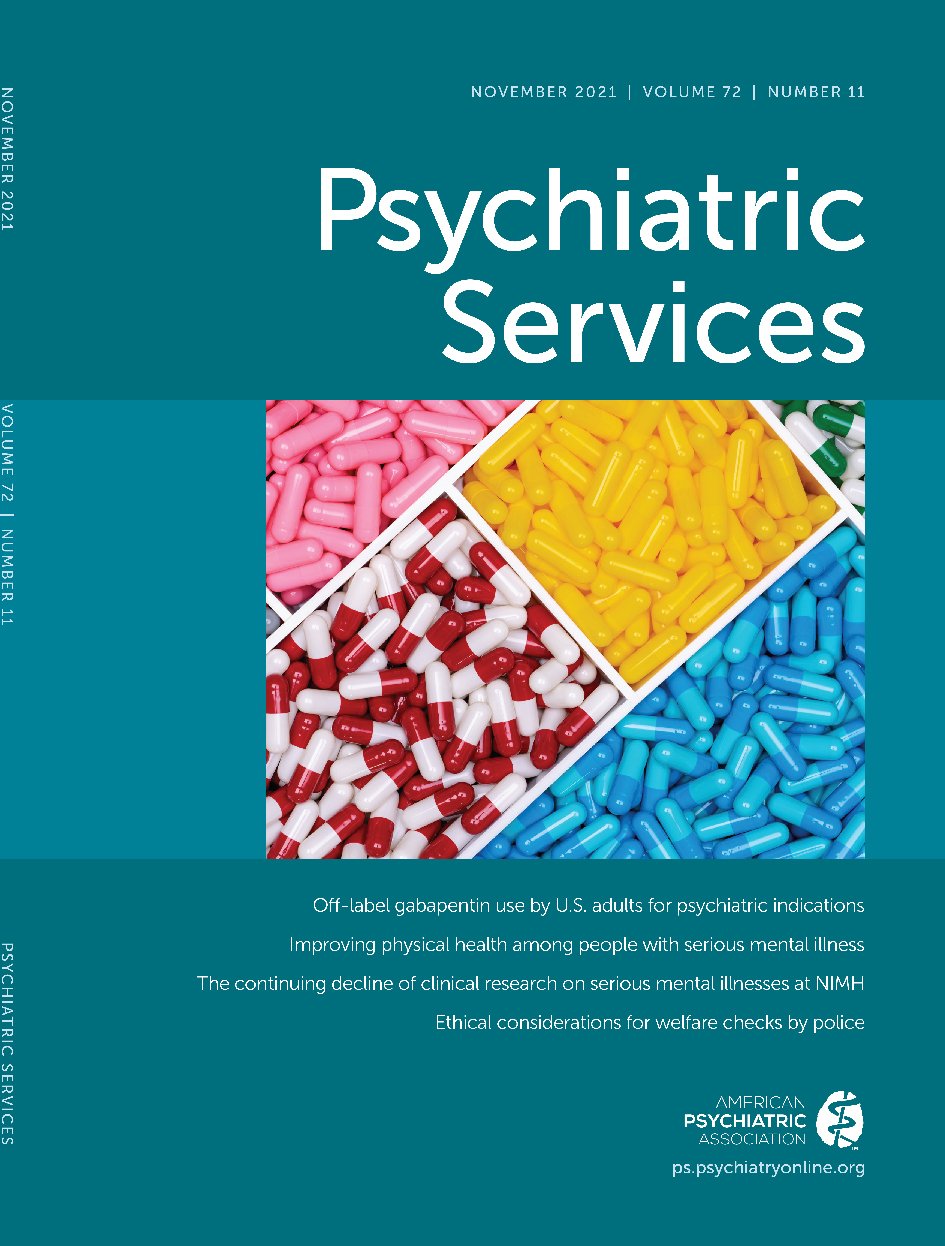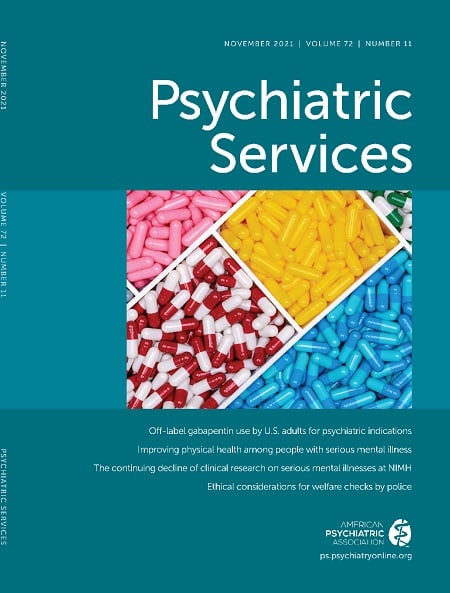The COVID-19 pandemic has been devastating. Individuals with serious mental illness are especially vulnerable to the virus (
1) and may have increased rates of viral transmission (
2). Neuropsychiatric disorders may impair adherence to COVID-19 safety guidelines, such as wearing face masks, and quarantining can worsen the psychiatric and general medical health of patients with serious mental illness. Individuals with serious mental illness may be at greater risk of death from COVID-19 because of exacerbation of prepandemic health care disparities, stigma, decreased social and financial support, and unstable housing (
3).
Black and Latinx patients with serious mental illness are at increased risk, and Black and Latinx communities have been disproportionately affected by COVID-19 (
4). Compared with White individuals, Black and Latinx individuals are more than twice as likely to die from COVID-19 because of structural racism manifesting in differential treatment by health care providers; lower average income; and greater representation among frontline workers, leading to increased virus exposure. In addition, higher rates of underlying conditions among Black Americans have been tied to “weathering,” or increased stress caused by racism (
4).
Long-term psychiatric services strive to provide care in the least restrictive settings and to promote community integration, but COVID-19 has had a significant impact on these practices. Community-based activities entail repeated exposure of patients to the community, which can heighten the risk of viral spread in the congregate-care setting when patients return to the facility. Tensions exist between many Centers for Disease Control and Prevention (CDC) infection prevention guidelines (
6) and the typical treatment goals for long-term psychiatric patient recovery. In this column, we highlight these tensions, identify the barriers patients face when infection prevention and recovery goals conflict, and propose principles for developing safe yet humane policies governing reopening. We suggest an approach that balances public health metrics, informed consent, risk mitigation methods, and respect for persons.
Barriers to Safe Discharge
The COVID-19 pandemic has led to several infection prevention safeguards that have become commonplace across the world. Although these public health interventions are necessary, they conflict with standards of treatment in some long-term psychiatric institutions, which typically incorporate group therapeutic programming, communal dining, shared living spaces, and slow transitions to community settings.
In particular, many state-funded hospitals care for individuals with serious mental illness, who may have symptomatology and cognitive impairment that reduce their capacity to attend to typical COVID-19 safeguards. Because of the illness severity of patients, lengths of stay in some long-term inpatient settings can be measured in months or years. As a result, the CDC’s COVID-19 guidelines for nursing homes (
7) are often more appropriate for these inpatient settings than are the guidelines for acute-care hospitals. To date, the CDC has not published guidelines specific to long-term psychiatric facilities, but in July 2020 it added a Wyoming psychiatric hospital’s report (
8) detailing the hospital’s method of COVID-19 outbreak control to its guidelines. Both resources (
7,
8) include infection prevention measures that could hinder patients’ psychiatric recovery, especially for those with serious mental illness. The recommendations include immediate isolation of new patients in separate rooms until receipt of their COVID-19 test results, isolation and management of new patients with positive test results in a separate ward for up to 2 weeks, cancellation of group dining, cancellation of group therapy or reduction of the number of persons participating in group therapy sessions, and limitations to all nonessential visitors and services. Such measures, although important for infection prevention, may exacerbate patients’ psychiatric symptoms because of feelings of isolation and loneliness and may sever connections with their natural support systems.
In many psychiatric settings, to supplement treatment or to address deficits created by these infection prevention guidelines, other therapeutic modalities, such as telepsychiatry have been implemented (
5). Unfortunately, resources and technologies in long-term care settings may not be readily available or may be limited. Skill-building community visits are another important component of patients’ recovery in these settings. These visits have been significantly reduced or eliminated during the COVID-19 pandemic to reduce the risk of institutional outbreak from community exposure. As a result, patients have been cut off from their usual activities without the ability to meaningfully replace or supplement them.
Transitions from long-term inpatient settings to the community are often prolonged. As opposed to acute-care inpatient settings, where a 7-day hospitalization leads to rapid discharge after amelioration of acute symptoms, in some long-term care settings, discharges are slow transitions that may take place over weeks or months. Discharges from such settings are typically prolonged because of the increased safety risk posed by these seriously ill patients or to slowly acclimate patients to the community after extended periods of institutionalization. The practice of having a patient visit an outpatient community setting for multiple day or overnight visits and returning to the long-term inpatient setting repeatedly before eventual discharge is antithetical to many COVID-19 infection prevention principles. Infection prevention calls for decreased interpersonal contact and decreased movement of patients between settings. Without the ability to engage in slow transitions that allow community treatment providers to assess patient responses to the change in environment, it becomes more challenging to discharge such patients and help them advance in their recovery. In addition, because of the pandemic, the availability of and access to such community placements has been significantly limited, further complicating discharge processes.
Strategies to Overcome Barriers to Safe Discharge
Although continued isolation minimizes the risk of COVID-19 infection, such policies limit patients’ access to therapeutic services, delay community reintegration, extend confinement, and negatively affect patient quality of life. At the height of the pandemic, health risks rightly outweigh these other considerations. When communities begin to recover and plan for the future, states must develop cautious yet humane plans to restart community- and group-based mental health services in long-term care settings. We suggest that these plans be based on four fundamental principles to ensure transparency and fairness, while also protecting patient and staff safety. First, recovery plans should be informed by the best available evidence concerning COVID-19 transmission, with sustained community transmission serving as a guidepost. Second, recovery plans should be iterative and self-reflective, using established models of quality improvement, such as the Plan-Do-Study-Act (PDSA) cycle. Third, informed consent must be a mainstay both in policy development and policy implementation. Fourth, recovery plans should take into account that patients from marginalized populations, particularly those who identify as Hispanic, Latinx, or Black, are more likely to be returning to communities devastated by the virus. These four principles (discussed below) are consistent with approaches taken by other public institutions, such as state governments and schools.
Recovery plans must be evidence based, and COVID-19 community transmission rates are of paramount importance. Unlike community-based populations, patients residing in long-term care settings are typically sequestered from the community at large—they are, in effect, quarantined. Restarting services with community contact will necessarily involve a heightened level of risk to patients. If an individual is exposed to COVID-19, the risk for COVID-19 spread in the congregate-care setting is significant, particularly for psychiatrically impaired individuals who often are unable to attend to typical COVID-19 safeguards. As in other risk-based decisions, acceptance of some level of risk is the cost for increased personal liberties (
9). At the same time, some cutoff point exists whereby the risks of infection outweigh the benefits of service provision. Each institution must make its own determination as to where this point precisely lies, but one useful heuristic is sustained community transmission.
Sustained community transmission occurs when infections propagate across multiple clusters of cases, with exponential spread within clusters, thereby putting an entire community at risk (
10). When the risk of infection is so widespread, institutions are justified in maintaining isolation, because any community contact can potentially introduce COVID-19 into the institution. Once exposed, long-term care facilities, like correctional facilities, nursing homes, and other congregate-care settings, are at high risk for rapid spread of the virus (
5). However, once infection rates decline so that sustained community transmission no longer occurs, reopening can begin. Many states have developed reopening plans for schools, businesses, and other state-operated functions (
11). Developing guidelines and policies for reopening long-term psychiatric care settings can largely follow similar processes. Such proposals ought to consider statewide reopening plans and important public health metrics, such as rates of community transition, as well as COVID-19 rates among both patients residing and staff working in the institution. Plans must consider how to slowly and safely advance from absolute lockdown toward the multitude of pre–COVID-19 therapeutic activities and functions, including staffing, group treatment, communal housing and dining, local integration of patients within the institution, and community reintegration. Akin to school reopening, plans can be tiered based on the degree of risk in the state and local institution (
12).
Plans can be structured around improvement science methodologies, such as the PDSA cycle. The PDSA cycle refers to testing a change by developing a plan to test the change (plan), carrying out the test (do), observing and learning from the consequences (study), and determining what modifications should be made to the test (act) (
13). Following this methodology will allow states to plan and then implement incremental changes that advance patients’ recovery goals while only slightly increasing the risk of COVID-19 exposure at each step. Such advancements can be implemented for a specified duration, after which an assessment can be undertaken to determine whether the exposure has been implemented safely or has actualized into increased risk. If rates of COVID-19 have not increased, lessons learned can be used to enhance the implemented changes and to move slowly forward toward additional recovery interventions. If rates have increased, states will need to slow or stop further advancement until COVID-19 can be managed and contained via the implementation of additional safeguards.
As plans are developed, one essential consideration will be informed consent, both when policies are devised and when they are implemented. Patients are top stakeholders because they will be taking on the risks of participating in any community- or group-based activities. In establishing COVID-19 reopening plans, administrators and clinicians should collaborate with patients and patient representatives so that the people most affected can participate in the decision-making process. In addition, once policies are created, individual patients should be permitted to accept or decline community- and group-based activities. Those patients who are competent to make medical decisions should also be able to determine what level of infection risk they are willing to undertake to further their psychiatric treatment goals. Meanwhile, clinicians may need to consult with surrogate decision makers, such as family members or guardians, for patients who lack medical decision-making capacity.
Finally, recovery plans should account for the disparate effects of COVID-19 on Black, Latinx, and other patients from marginalized backgrounds, who are more likely to be returning to communities that have been disproportionately affected by the virus. Recovery plans should incorporate resources to aid Black and Latinx patients in grieving for their communities and loved ones and in helping them to transition back into communities that may have drastically changed since these patients were initially admitted to the hospital. These losses necessitate additional support services, which may include connecting Black and Latinx patients with therapists and psychiatrists from congruent backgrounds to help them heal from the devastating impact of COVID-19.

